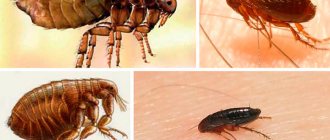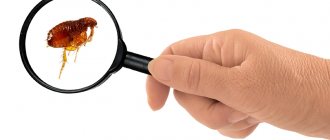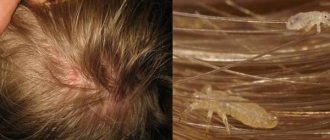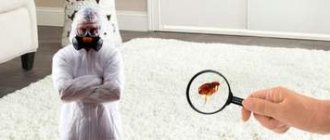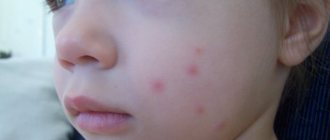This article discusses the main points that you need to know if fleas appear in the house: a description of the parasite, the reasons for the appearance of fleas in humans, the main signs of their presence, the dangers that these harmful insects pose and effective methods of combating them.
Fleas are blood-sucking insects that can parasitize any warm-blooded organism. They do not have a specific focus on the host's species. There are several types of fleas depending on the prey they prefer. But there is also a little-known fact of the existence of the human flea. That is, this insect chooses the human body as its host.
Where do fleas come from in an apartment?
Before you understand how to get rid of fleas in an apartment, you need to know where they come from.
Fleas live on many continents, they are very unpretentious and have adapted to survive in any, even the most difficult conditions. How do they get into the apartment?
The first and most likely reason for the appearance of these blood-sucking insects near people is that they get on the body of pets that are walked outdoors. The most likely habitats for them are basements of houses, grass on lawns and other animals. A flea, once on the fur of a pet, does not reveal itself for some time and begins to lay eggs, which can then fall onto the floor or carpet, from where numerous individuals subsequently hatch.
These harmful bloodsuckers, despite their tiny size, are capable of jumping high, so they can sometimes be found in woolen clothes, on windowsills in flowers and in other places. But most often these pests live closer to the floor, they hide behind baseboards, in carpets, furniture, and love to live in the bedding of pets. Therefore, you will need to start breeding them from your own furry animal and its habitat.
However, if you do not have pets, but fleas still appear, then there are other ways for them to enter. In this case, they enter the apartment directly from the entrance of your house, from the attic, from the balcony, they can sneak in from neighbors, traveling through the ventilation pipe, and they can also be carried by all kinds of rodents if they have access to the underground of the apartment.
Stranger in a mask
Y. pestis has long been hidden from the human eye due to many circumstances. At first, size was an obstacle: before the invention of the microscope by the Jansen brothers in 1590* and its further use by Hooke and Leeuwenhoek (to whom, by the way, bacteria and protozoa were born), no one even thought about the fact that in addition to living objects visible to the eye There are also tiny organisms. But even with the advent of optics, the plague bacillus continued to maintain its incognito status, blaming bacteria of the genera Bacterium, Bacillus and Pasteurella. Meanwhile, Y. pestis roamed freely around the world and claimed more lives than the war.
* — You can read more about the wonders of microscopy in the articles “Seeing is better, or super-high-resolution microscopy” [1] and “Beyond the diffraction barrier: Nobel Prize in Chemistry 2014” [2].
There have been three known plague pandemics throughout history. The first of these was the “Justinian Plague” (named after the Byzantine ruler Justinian I), which swept through the entire civilized world of that time. Historians date it back to 541-580 AD, although outbreaks of an unknown disease plagued humanity for another two centuries. According to the famous vector researcher, medical entomologist Milan Daniel, at the peak of the disease in Constantinople (now Istanbul, Turkey), up to ten thousand people died every day. Based on modern research, scientists have concluded that half of Europeans died long before the plague left the thinned and exhausted population.
The second pandemic, best known as the Black Death, began its attack on Europe in 1346. Brought from Eastern China along the Great Silk Road to the Crimea, the infection quickly made its way north, and within four years managed to claim the lives of more than 25 million people, which at that time amounted to a third of the entire European population. The disease did not give up for four centuries - it either hid or flared up (mainly in large cities), wandering from country to country. In 1665-1666, one in five Londoners died from the bubonic plague [3]; but, despite the deplorable situation, medicine remained powerless.
How dangerous are fleas for people and pets?
The presence of fleas in an apartment is unpleasant, first of all, because they bite all warm-blooded creatures, including people. The results of their bites can appear on the skin as red spots, inflammation and swelling, and some people may suffer from severe allergies. But the biggest danger is parasite-borne diseases such as sarcopsillosis and pulicosis. In addition, insects can be carriers of various parasites and pathogens of such dangerous diseases as Hepatitis; Brucellosis; Tick-borne encephalitis; Salmonellosis; Typhus; Myxomatosis and a number of others. There are over 25 diseases on this list. The most dangerous infectious fleas are those carried by rats. If they bite infected animals, they become infected from them, but do not die, but only become carriers of dangerous diseases. During the bite process, sick parasites infect their victim. It is especially dangerous when insects bite elderly people and small children. Typically, these bloodsuckers choose people who have thin, delicate skin, as it is easier for them to bite through it. If the skin is sensitive, then the bites will take a long time to heal and will be difficult, they will cause itching and cause aesthetic discomfort to the person. For women, the aesthetic component is especially unpleasant, since with bitten legs you will not be able to wear dresses in hot weather, but will have to cover yourself with trousers.
All these troubles can be avoided if, when these parasites are discovered, they are poisoned immediately.
How to treat bites with folk remedies? When a bite occurs, a person may not even notice it, since the insect produces and injects pain-relieving enzymes, allowing it to unhinderedly suck blood. Bite areas should be immediately treated with a cotton swab moistened with alcohol. If there is swelling, you can apply ice. Then lubricate with any antiseptic.
Victim of mutation
It has been known for quite some time that the ancestor of the plague bacillus is Yersinia pseudotuberculosis, an enteropathogen, the causative agent of pseudotuberculosis. Presumably, Y. pestis separated from its ancestral species about twenty thousand years ago. The reason for the evolution was a sharp climate change in the late Pleistocene (the Quaternary period of the Cenozoic era): cold was replaced by heat, causing a restructuring of ecosystems; As a rule, such weather “jumps” stimulate the evolution of species [5]. However, until recently, the genetic changes critical for the transformation of a pathogen that causes an infectious intestinal disease into a dangerous microorganism that can infect the lungs and provoke fulminant sepsis were not known.
The evolutionary branch of Y. pestis was studied by scientists from Northwestern University in the USA. In the study, Wyndham Lathem and Daniel Zimbler found that the acquisition of a single gene transformed early forms of Y. pestis, already somewhat genetically and phenotypically different from Y. pseudotuberculosis, into a successful pulmonary pathogen. To identify the mechanism of “relocation” of the plague bacillus from the intestines to the lungs, the authors conducted experiments on ancient strains of bacteria and analyzed their behavior in the body of mice. When comparing strains that cause pneumonic plague with relatively harmless ancestors, only one, but very significant, difference was revealed: the acquisition of the surface protein Pla (see sidebar) as part of the pPCP1 plasmid became critical. To test the hypothesis, this gene was introduced into the DNA of evolutionarily earlier strains - and the results confirmed the involvement of the Pla protease in effective damage to the respiratory tract.
However, this acquisition of Y. pestis was not enough to learn how to cause a very dangerous systemic infection (septic form of plague). It turned out that such an improvement required only one (!) amino acid substitution in the Pla protein - I259T . This substitution optimized the proteolytic activity of the protein and significantly increased the invasive potential of bacteria during the development of bubonic plague. Thus, scientists believe that first of all, the bacterium acquired the properties of a pulmonary pathogen, a provocateur of outbreaks of pneumonic plague, and later, as a result of an additional mutation, even more dangerous strains appeared that cause pandemics of pulmonary septic and bubonic septic plague [6].
Nevertheless, among all the disadvantages of Y. pestis, scientists also find advantages of its contact with people. In 2014, the journal PLoS ONE published an article by Sharon de Witte from the University of South Carolina, which stated that people who survived the plague pandemic experienced better health. Scientists examined the remains of people who lived before, during and after the plague, paying special attention to the causes of death and the condition of their bones. The results showed that survivors of the epidemic, as well as their descendants, lived on average to 75 years and had enviable immunity.
How to remove fleas
It is possible to completely get rid of parasites, and it is not that difficult to do. First you need to identify the reason for their appearance in the apartment. If they enter the house on pets, then treat them and treat the places where the animal spends the night and spends its time. If fleas have made their way to you from the basement, then you need to start by protecting your home from their repeated invasion through balcony cracks and other places. Folk remedies for fighting fleas, popular among the population, bring certain benefits, but it is wiser to use them along with chemicals that are sold in specialized departments of hardware stores. It is also advisable to use them as preventive measures. But most likely you will not be able to completely exterminate a large colony of parasites with their help. Today, there are many reliable insecticidal preparations that will quickly rid your living space of these bloodsuckers. Fighting with insecticides will bring the desired effect and will not cause trouble if the owners strictly follow the instructions and follow all safety measures. If the treatment does not produce results after two attempts, then it is advisable to call the sanitary and epidemiological service for help.
How to properly treat an apartment for fleas
You need to poison fleas when they have already bred, but it is best to prevent the problem. To prevent the invasion of parasites, regular wet cleaning and vacuuming of carpets is necessary.
Start treating the room from places where insects are most likely to hide. Typically, these are hard-to-reach places behind pieces of furniture, baseboards, corners, carpets, bedspreads, especially those on which there may be a pet and dusty soft toys.
List of measures:
- Using a vacuum cleaner you can remove up to half of all flea eggs. Subsequent cleaning of the vacuum cleaner is mandatory;
- Chemical anti-flea agents are the most effective way to kill adult fleas, as well as prevent the development of eggs and the emergence of larvae from them. The following drugs are widely known: Pyroproxyfen (its second name is Nilar);
- In open spaces, experts advise using foggers - installations for humidification, and aerosols for treating hard-to-reach areas.
- People's experience shows that treatment with ammonia and eucalyptus tincture, which should be diluted in water and used to wash floor coverings, will help. Some people treat their apartments with such radical chemicals as turpentine and denatured alcohol, but it is impossible to say that such treatment will help completely. Of course, any parasite will not feel comfortable with such an attack, but people will not be able to live there for a long time.
What fleas can bite humans
In addition to Pulex irritans, other species of this family that do not have a clear attachment to certain species of animals or birds can attack people.
Most often we are bitten by insects that live on:
- dogs;
- cats;
- rats. Rat fleas were carriers of the most terrible medieval disease - the plague;
- rabbits.
The most painful flea bite can be obtained from a parasite that lives on a large animal. For example, a moose flea bite is more painful than a bee bite.
How to get rid of fleas from your pets
Nowadays, there are a lot of different flea control products sold on the pet care market. All of them can be divided into groups:
- Preparations for local use with a long period of action. Their range is huge.
- Anti-flea drops are widely used. The drug is applied to the withers of a woolly pet. This medicine is easy to use, and if you follow the instructions strictly and make sure that it is suitable for the animal, you will definitely get results.
- Sprays are in aerosol cans. They are designed to completely process the animal's fur; even areas around the eyes and ears must be disinfected. In this case, the spray must not get on the pet’s eye mucosa.
- Bath solutions. They are rarely used, as animal owners are afraid for the health of their pet, because the effect occurs on all skin integuments at once. But these products are absolutely safe if the animal is healthy. Before bathing, the pet's ears are covered with cotton to prevent liquid from getting into them.
- Shampoos with anti-flea effect. Lather the animal with this shampoo and keep it in the foam for 10 minutes. This type of flea control is characterized by the least toxicity, but has a delayed effect, but a long period of exposure.
- A flea collar kills parasites when used correctly. Adjust the strap on the animal so that two fingers can fit under it. If irritation occurs, do not use such a collar, but buy a product from a different manufacturer. Air the flea collar for a couple of days before use.
- Oral medications in tablets and ampoules for injection. These medications contain components that inhibit the formation of fleas. Tablets are usually given once a month, and injections are given once every six months. Along with these measures, it is necessary to combat adult individuals.
- Combs, combs. Most pets, especially cats, adore these products; they themselves run to the procedure. These items are absolutely safe.
When choosing a method of combating parasites, you need to take into account the breed, health status, type, degree of infestation, age and other factors.
What do bedbugs look like?
Insects are distinguished by a flat, wide body measuring from 4 to 8 mm. This body shape helps parasites survive in bed conditions, reducing the risk of being crushed by a sleeping person. In a well-fed state, they enlarge and become more vulnerable. Bedbugs have no wings, and the constrictions on the back are clearly visible. Bedbug larvae are similar to adults, but their color is less saturated. The eggs of these insects can be mistaken for small grains of rice. Their length does not exceed one millimeter.
Traditional methods of combating flea infestations
Herbal tinctures, which have a pungent and characteristic odor, not only help expel parasites from your home, but also serve as a good preventive measure for their reappearance.
Flea tincture recipe: eucalyptus 1 tbsp. l., tansy 1 tbsp. l. and wormwood 2 tbsp. l. Mix everything and pour one glass of boiling water into the mixture. Leave for 10 hours. Strain, place in a spray bottle and irrigate the room.
Make a bag out of cotton fabric and fill it with pine sawdust. You will get a pillow for your pet that will repel fleas with the aroma of pine.
On the threshold of the apartment, scatter sawdust from coniferous trees mixed with wormwood . Parasites will not jump close to such a barrier.
Ventilate your apartment daily , as fleas are sensitive to cool air. In summer, air woolen items, bedspreads, mattresses, etc. on the balcony.
Recipe with soda. Prepare a mixture of baking soda and salt in equal proportions. Sprinkle it in places where fleas are likely to live and after ten hours, vacuum the surfaces. For prevention, repeat the procedure.
Yeast recipe. Mix brewer's yeast with crushed garlic and sprinkle it on your floors and carpets. After 10 hours, go through with a vacuum cleaner.
Flea defense mechanisms
In addition to the fact that the flea's body is flat, it is covered with a strong chitinous covering. This tough protective covering allows these insects to remain unharmed when captured. Only a very great force allows you to destroy this cover and crush the flea - you just can’t crush it with your fingers - it’s not for nothing that cats and dogs bite them with their teeth. Thanks to the presence of these protective mechanisms, fleas have no reason to hide in cracks or sneak up in the dark. Also, the flea does not have a special anesthetic enzyme, like many other blood-sucking insects - it simply cannot be seen or crushed, it is invulnerable!
.
Structure of a flea
.
Preventive actions
To prevent a re-infestation of fleas, you need to follow these simple rules.
- Do wet cleaning twice a week, including in remote areas.
- Train your pet to wear a flea collar.
- Treat the entrance to the living space and ventilation with special crayons.
- Ventilate your apartment periodically.
- Hang bedding in the sun.
- Wash soft toys and treat upholstered furniture.
- If necessary, carry out repairs by covering all cracks in the floor, walls, etc.
- Don't let other people's animals into your apartment.
If you disinfect your apartment and adhere to preventive measures, you will not only get rid of flea infestations, but also prevent them from reappearing.
A little about Pla
Figure 1. Mechanism of prevention of apoptosis by the Y. pestis Pla protease. On the left is normal Fas signaling upon inactivation of Pla, on the right is suppression of apoptosis by the “working” protease. FasL is a transmembrane protein localized on the surface of lymphocytes; Fas—FasL receptor; Pla is a protease embedded in the outer membrane of the bacterial cell. Figure from [7].
Why is the Pla protease classified as a virulence factor, that is, how exactly did it help the plague bacillus, which already boasts a rich arsenal of adaptations for thriving in mammals and transmission by fleas? One of the responsibilities of Pla is the activation of plasminogen: the resulting plasmin destroys fibrin clots, which is important, for example, for the spread of bacteria from buboes throughout the body.
The development of primary pulmonary infection has recently been linked to a mechanism involving the inactivation of an apoptotic signaling molecule called Fas ligand (FasL). The role of FasL in the cell is determined by its ability to trigger the process of apoptosis. This protein, which spans the membrane of activated cytotoxic T lymphocytes and airway epithelial cells, has an extracellular domain that binds to the FasR receptor on the surface of other cells (mainly lymphocytes, but also hepatocytes, cancer and some others), which, through activation of caspase proteases, 8 and caspase-3/7 trigger apoptosis. This maintains the homeostasis of immunocytes, prevents autoimmune processes and destroys cells expressing foreign antigens.
Pla protease catalyzes the cleavage of the FasL “working” domain in several places and thereby inactivates this protein—both its membrane and soluble forms. Thus, Pla prevents apoptosis and associated inflammatory reactions necessary for a full immune response, which promotes the survival of the pathogen in the host (Fig. 1) [7].
Experiments carried out on mice showed the following: bacteria with normal Pla protease contributed to a decrease in the amount of FasL, which led to rapid colonization of the lungs, while Yersinia with inactivated Pla multiplied more slowly. The described mechanism of suppressing the immune response, according to scientists, can be used by other pathogens, especially those causing respiratory tract infections. And this, in turn, opens up new prospects in the fight against such diseases: you can think, for example, about developing Pla inhibitors or introducing additional FasL molecules [7].
Symptoms of human flea infestation
Fleas can bite any warm-blooded creature, but parasites always have preferences. Symptoms of human flea bites are as follows:
- Bites appear on the legs, arms and neck - anywhere the parasite can reach while a person sleeps.
- The marks are similar to mosquito marks, but they itch more and take longer to go away.
- Bite marks are located in groups on the skin: the parasite makes several punctures on the skin, but not in paths, as bedbugs do.
Women and children with more delicate skin and increased sensitivity react most acutely to bites. But the human flea is not picky; it doesn’t matter who it bites - children or adults.
Fleas can appear in humans from contact with animals, being in an infested room, or going out into nature. They are easily transmitted from animals, even dogs and cats. Treatment of bites must begin as soon as they are detected in people living in the room. The consequences of bites can be allergies, and fleas are carriers of many dangerous diseases.
The symptoms together form a separate disease - pulicosis. It refers specifically to flea bites, which can only occur in humans.
